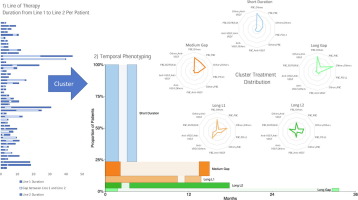Journal of Biomedical informatics ( IF 4.5 ) Pub Date : 2019-11-02 , DOI: 10.1016/j.jbi.2019.103335 Weilin Meng 1 , Wanmei Ou 1 , Sheenu Chandwani 1 , Xin Chen 1 , Wynona Black 1 , Zhaohui Cai 1

|
Lines of therapy (LOT) derived from real-world healthcare data not only depict real-world cancer treatment sequences, but also help define patient phenotypes along the course of disease progression and therapeutic interventions. The sequence of prescribed anticancer therapies can be defined as temporal phenotyping resulting from changes in morphological (tumor staging), biochemical (biomarker testing), physiological (disease progression), and behavioral (physician prescribing and patient adherence) parameters. We introduce a novel methodology that is a two-part approach: 1) create an algorithm to derive patient-level LOT and 2) aggregate LOT information via clustering to derive temporal phenotypes, in conjunction with visualization techniques, within a large insurance claims dataset. We demonstrated the methodology using two examples: metastatic non-small cell lung cancer and metastatic melanoma. First, we generated a longitudinal patient cohort for each cancer type and applied a set of rules to derive patient-level LOT. Then the LOT algorithm outputs for each cancer type were visualized using Sankey plots and K-means clusters based on durations of LOT and of gaps in therapy between LOT. We found differential distribution of temporal phenotypes across clusters. Our approach to identify temporal patient phenotypes can increase the quality and utility of analyses conducted using claims datasets, with the potential for application to multiple oncology disease areas across diverse healthcare data sources. The understanding of LOT as defining patients’ temporal phenotypes can contribute to continuous health learning of disease progression and its interaction with different treatment pathways; in addition, this understanding can provide new insights that can be applied by tailoring treatment sequences for the patient phenotypes who will benefit.
中文翻译:

通过挖掘医疗保健数据来推导癌症的治疗方法,进行时间表型分析。
从现实世界的医疗保健数据中得出的治疗线(LOT)不仅描绘了现实世界中的癌症治疗序列,而且还有助于定义疾病进展和治疗干预过程中的患者表型。处方抗癌治疗的顺序可以定义为因形态(肿瘤分期),生化(生物标志物检测),生理(疾病进展)和行为(医师开处方和患者依从性)参数变化而产生的时间表型。我们介绍一种新颖的方法,该方法分为两部分:1)创建一种算法来导出患者级别的LOT; 2)通过聚类以在大型保险理赔数据集中结合可视化技术,通过聚类得出LOT表型,以汇总时间表型。我们使用两个示例演示了该方法:转移性非小细胞肺癌和转移性黑色素瘤。首先,我们针对每种癌症类型生成了一个纵向患者队列,并应用了一组规则来得出患者水平的LOT。然后,根据LOT的持续时间和LOT之间的治疗差距,使用Sankey图和K-均值聚类显示每种癌症类型的LOT算法输出。我们发现跨簇的时间表型的差异分布。我们用于识别患者临时表型的方法可以提高使用理赔数据集进行的分析的质量和实用性,并有可能应用于跨各种医疗数据源的多个肿瘤疾病领域。了解LOT定义患者的时间表型可以有助于持续学习疾病进展及其与不同治疗途径的相互作用;此外,这种理解可以提供新的见解,可以通过为将受益的患者表型定制治疗序列来应用这些见解。


























 京公网安备 11010802027423号
京公网安备 11010802027423号